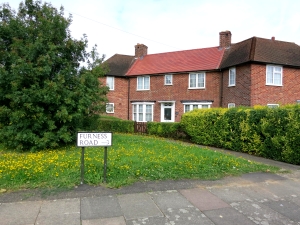Along the footpath to the mosque this morning a heap of building waste demonstrated that the flytipping (2nd. July) warnings have been ignored. When I returned from my walk, it was still there, and a man was standing at the entrance holding up a board which announced that the Eid (15th. August) carpark was full. There was a queue of hopeful drivers in their cars stretching out into Hillcross Avenue. At the head was a vehicle full of Muslim women. I moved some of the rubble, hoping it wasn’t asbestos, so the driver could park there. A young Muslim man who had just parked alongside it declined to help. After that the other, male, drivers were on their own. Chivalry extends only so far.
Blackberries were ripening, to the delight of foragers. Bindweed was rampant. This menace was the curse of our tiny garden in Stanton Road. I spent many hours as a child chipping away at the sun-hardened soil with a small garden fork, endeavouring to remove the last vestiges of trailing white roots. The Forth bridge wasn’t in it.
Bindweed was rampant. This menace was the curse of our tiny garden in Stanton Road. I spent many hours as a child chipping away at the sun-hardened soil with a small garden fork, endeavouring to remove the last vestiges of trailing white roots. The Forth bridge wasn’t in it.
Turning right onto London Road, I passed an old milestone. This is a relic of the days of horse-drawn coaches. I walked up to the crossroads and turned left, rounding into Green Lane which runs parallel to it. This wide thoroughfare, with a tree-lined path running down the centre of it, begins in the Upper Morden Conservation Area. It is part of the 1950s St. Helier Estate.  This vast post-war housing project contains beautifully built and spaciously laid out properties. I think this was the last period of well-made council housing.
This vast post-war housing project contains beautifully built and spaciously laid out properties. I think this was the last period of well-made council housing.  Like many other local authority homes, some are now privately owned. It was Margaret Thatcher’s ‘Right to Buy’ policies that made this possible. Undoubtedly this did enable a great number of people who would be unable to do so to become owner-occupiers. It also reduced the amount of housing stock to accommodate those who could not afford to buy. I have mentioned before (28th. June) that I worked in Westminster during the Shirley Porter era. Looking out of my office window, or those of Beauchamp Lodge Settlement, I wondered at the fact that Council owned residential flats were being tarted up and otherwise embellished, for example, with sloping roofs. Some of these, no more than ugly boxes built in the ’60s, could certainly have done with it. Other Council Housing Department properties were being boarded up. Since there were numerous homeless families in the City of Westminster, this was another mystery. What I had not been aware of was the scandalous gerrymandering that was going on. My naive nature had imagined that money was being spent on improving the environment of Council tenants. It was nothing of the kind. Their homes were being prepared for sale to potential Tory voters. Fortunately the worst of this abuse was not implemented until after I had, in 1986, left the Authority’s employment. I would not have been able to stomach the enforced transportation of Westminster’s homeless families to hotel accommodation in other parts of London, to which the borough’s hapless people were being decanted.
Like many other local authority homes, some are now privately owned. It was Margaret Thatcher’s ‘Right to Buy’ policies that made this possible. Undoubtedly this did enable a great number of people who would be unable to do so to become owner-occupiers. It also reduced the amount of housing stock to accommodate those who could not afford to buy. I have mentioned before (28th. June) that I worked in Westminster during the Shirley Porter era. Looking out of my office window, or those of Beauchamp Lodge Settlement, I wondered at the fact that Council owned residential flats were being tarted up and otherwise embellished, for example, with sloping roofs. Some of these, no more than ugly boxes built in the ’60s, could certainly have done with it. Other Council Housing Department properties were being boarded up. Since there were numerous homeless families in the City of Westminster, this was another mystery. What I had not been aware of was the scandalous gerrymandering that was going on. My naive nature had imagined that money was being spent on improving the environment of Council tenants. It was nothing of the kind. Their homes were being prepared for sale to potential Tory voters. Fortunately the worst of this abuse was not implemented until after I had, in 1986, left the Authority’s employment. I would not have been able to stomach the enforced transportation of Westminster’s homeless families to hotel accommodation in other parts of London, to which the borough’s hapless people were being decanted.
Coming to the end of Green Lane, at the Rose Hill roundabout I turned right, eventually reaching Sutton Common Road, where I took another right turn which brought me to Epsom Road. Right again and I was soon able to enter Morden Park and make for home. Along the road from Rose Hill I came across another roadside memorial (see 12th. August) fixed to the common railings.
Along the road from Rose Hill I came across another roadside memorial (see 12th. August) fixed to the common railings.
In Morden Park I discovered a fully equipped Cricket ground in a bucolic setting which I had not noticed before. There is more to this open space than I had imagined; and much to be discovered on one’s own doorstep.
Later, Jackie and I drove to The Firs. We had curries and beer at Eastern Nights.

